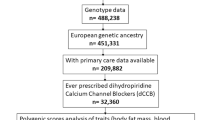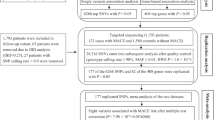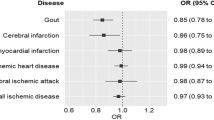Abstract
Glucose–insulin–potassium (GIK) therapy may promote a shift from oxygen-wasteful free fatty acid (FFA) metabolism to glycolysis, potentially reducing myocardial damage during ischemia. Genetic variation associated with FFA response to GIK was investigated in an IMMEDIATE (Immediate Myocardial Metabolic Enhancement During Initial Assessment and Treatment in Emergency care) sub-study (n=117). In patients with confirmed acute coronary syndromes, associations between 132 634 variants and 12-h circulating FFA response were assessed. Between initial and 6-h measurements, three LINGO2 variants were associated with increased levels of total FFA (P-value for 2 degree of freedom test, P2df ⩽5.51 × 10−7). Lead LINGO2 single-nucleotide polymorphism, rs12003487, was nominally associated with reduced 30-day ejection fraction (P2df=0.03). Several LINGO2 signals were linked to alterations in epigenetic profile and gene expression levels. Between 6 and 12 h, rs7017336 nearest to IMPA1/FABP12 showed an association with decreased saturated FFAs (P2df=5.47 × 10−7). Nearest to DUSP26, rs7464104 was associated with a decrease in unsaturated FFAs (P2df=5.51 × 10−7). Genetic variation may modify FFA response to GIK, potentially conferring less beneficial outcomes.
This is a preview of subscription content, access via your institution
Access options
Subscribe to this journal
Receive 6 print issues and online access
$259.00 per year
only $43.17 per issue
Buy this article
- Purchase on Springer Link
- Instant access to full article PDF
Prices may be subject to local taxes which are calculated during checkout


Similar content being viewed by others
References
van der Vusse GJ, Glatz JF, Stam HC, Reneman RS . Fatty acid homeostasis in the normoxic and ischemic heart. Physiol Rev 1992; 72: 881–940.
Gertz EW, Wisneski JA, Stanley WC, Neese RA . Myocardial substrate utilization during exercise in humans. Dual carbon-labeled carbohydrate isotope experiments. J Clin Invest 1988; 82: 2017–2025.
Depre C, Vanoverschelde JL, Taegtmeyer H . Glucose for the heart. Circulation 1999; 99: 578–588.
Lee L, Horowitz J, Frenneaux M . Metabolic manipulation in ischaemic heart disease, a novel approach to treatment. Eur Heart J 2004; 25: 634–641.
Lopaschuk GD, Wambolt RB, Barr RL . An imbalance between glycolysis and glucose oxidation is a possible explanation for the detrimental effects of high levels of fatty acids during aerobic reperfusion of ischemic hearts. J Pharmacol Exp Ther 1993; 264: 135–144.
Heusch G . Hibernating myocardium. Physiol Rev 1998; 78: 1055–1085.
Steinberg HO, Tarshoby M, Monestel R, Hook G, Cronin J, Johnson A et al. Elevated circulating free fatty acid levels impair endothelium-dependent vasodilation. J Clin Invest 1997; 100: 1230–1239.
Steinberg HO, Paradisi G, Hook G, Crowder K, Cronin J, Baron AD . Free fatty acid elevation impairs insulin-mediated vasodilation and nitric oxide production. Diabetes 2000; 49: 1231–1238.
Apstein CS, Gravino FN, Haudenschild CC . Determinants of a protective effect of glucose and insulin on the ischemic myocardium. Effects on contractile function, diastolic compliance, metabolism, and ultrastructure during ischemia and reperfusion. Circ Res 1983; 52: 515–526.
Cave AC, Ingwall JS, Friedrich J, Liao R, Saupe KW, Apstein CS et al. ATP synthesis during low-flow ischemia: influence of increased glycolytic substrate. Circulation 2000; 101: 2090–2096.
Eberli FR, Weinberg EO, Grice WN, Horowitz GL, Apstein CS . Protective effect of increased glycolytic substrate against systolic and diastolic dysfunction and increased coronary resistance from prolonged global underperfusion and reperfusion in isolated rabbit hearts perfused with erythrocyte suspensions. Circ Res 1991; 68: 466–481.
Vanoverschelde JL, Janier MF, Bakke JE, Marshall DR, Bergmann SR . Rate of glycolysis during ischemia determines extent of ischemic injury and functional recovery after reperfusion. Am J Physiol 1994; 267: H1785–H1794.
Selker HP, Beshansky JR, Griffith JL, D'Agostino RB, Massaro JM, Udelson JE et al. Study design for the Immediate Myocardial Metabolic Enhancement During Initial Assessment and Treatment in Emergency Care (IMMEDIATE) Trial: A double-blind randomized controlled trial of intravenous glucose, insulin, and potassium for acute coronary syndromes in emergency medical services. Am Heart J 2012; 163: 315–322.
Selker HP, Beshansky JR, Sheehan PR, Massaro JM, Griffith JL, D'Agostino RB et al. Out-of-hospital administration of intravenous glucose-insulin-potassium in patients with suspected acute coronary syndromes: the IMMEDIATE randomized controlled trial. JAMA 2012; 307: 1925–1933.
Lemaitre RN, Tanaka T, Tang W, Manichaikul A, Foy M, Kabagambe EK et al. Genetic loci associated with plasma phospholipid n-3 fatty acids: a meta-analysis of genome-wide association studies from the CHARGE Consortium. PLoS Genet 2011; 7: e1002193.
Wu JH, Lemaitre RN, Manichaikul A, Guan W, Tanaka T, Foy M et al. Genome-wide association study identifies novel loci associated with concentrations of four plasma phospholipid fatty acids in the de novo lipogenesis pathway: results from the Cohorts for Heart and Aging Research in Genomic Epidemiology (CHARGE) consortium. Circ Cardiovasc Genet 2013; 6: 171–183.
Ellis KL, Zhou Y, Beshansky JR, Ainehsazan E, Yang Y, Selker HP et al. Genetic variation at glucose and insulin trait loci and response to glucose-insulin-potassium (GIK) therapy: the IMMEDIATE trial. Pharmacogenomics J 2014; 15: 55–62.
Ellis KL, Zhou Y, Beshansky JR, Ainehsazan E, Selker HP, Cupples LA et al. Genetic modifiers of response to glucose-insulin-potassium (GIK) infusion in acute coronary syndromes and associations with clinical outcomes in the IMMEDIATE Trial. Pharmacogenomics J 2015; 15: 488–495.
Krebs M, Stingl H, Nowotny P, Weghuber D, Bischof M, Waldhausl W et al. Prevention of in vitro lipolysis by tetrahydrolipstatin. Clin Chem 2000; 46: 950–954.
Voight BF, Kang HM, Ding J, Palmer CD, Sidore C, Chines PS et al. The metabochip, a custom genotyping array for genetic studies of metabolic, cardiovascular, and anthropometric traits. PLoS Genet 2012; 8: e1002793.
Grove ML, Yu B, Cochran BJ, Haritunians T, Bis JC, Taylor KD et al. Best practices and joint calling of the HumanExome BeadChip: The CHARGE Consortium. PLoS One 2013; 8: e68095.
Price AL, Patterson NJ, Plenge RM, Weinblatt ME, Shadick NA, Reich D . Principal components analysis corrects for stratification in genome-wide association studies. Nat Genet 2006; 38: 904–909.
Li J, Ji L . Adjusting multiple testing in multilocus analyses using the eigenvalues of a correlation matrix. Heredity (Edinb) 2005; 95: 221–227.
Zhang W, Gamazon ER, Zhang X, Konkashbaev A, Liu C, Szilagyi KL et al. SCAN database: facilitating integrative analyses of cytosine modification and expression QTL. Database (Oxford) 2015; 2015, e-pub ahead of print March 27 2015. doi: 10.1093/database/bav025.
Chen EY, Tan CM, Kou Y, Duan Q, Wang Z, Meirelles GV et al. Enrichr: interactive and collaborative HTML5 gene list enrichment analysis tool. BMC Bioinformatics 2013; 14: 128.
Consortium EP. An integrated encyclopedia of DNA elements in the human genome. Nature 2012; 489: 57–74.
Jonassen AK, Aasum E, Riemersma RA, Mjos OD, Larsen TS . Glucose-insulin-potassium reduces infarct size when administered during reperfusion. Cardiovasc Drugs Ther 2000; 14: 615–623.
Opie LH, Bruyneel K, Owen P . Effects of glucose, insulin and potassium infusion on tissue metabolic changes within first hour of myocardial infarction in the baboon. Circulation 1975; 52: 49–57.
Stanley AW Jr, Moraski RE, Russell RO, Rogers WJ, Mantle JA, Kreisberg RA et al. Effects of glucose-insulin-potassium on myocardial substrate availability and utilization in stable coronary artery disease. Studies on myocardial carbohydrate, lipid and oxygen arterial-coronary sinus differences in patients with coronary artery disease. Am J Cardiol 1975; 36: 929–937.
Rogers WJ, Stanley AW Jr, Breinig JB, Prather JW, McDaniel HG, Moraski RE et al. Reduction of hospital mortality rate of acute myocardial infarction with glucose-insulin-potassium infusion. Am Heart J 1976; 92: 441–454.
Opie LH, Knuuti J . The adrenergic-fatty acid load in heart failure. J Am Coll Cardiol 2009; 54: 1637–1646.
Ackerman L, Freeman ML, Pacold I, Barnes WE, Johnson B, Reid RW et al. Effect of acute postinfusion lipemia and free fatty acids on myocardial contractility: assessment with radionuclide ventriculography. Eur J Nucl Med 1986; 12: 201–204.
Nielsen R, Norrelund H, Kampmann U, Kim WY, Ringgaard S, Schar M et al. Failing heart of patients with type 2 diabetes mellitus can adapt to extreme short-term increases in circulating lipids and does not display features of acute myocardial lipotoxicity. Circ Heart Fail 2013; 6: 845–852.
Havmoeller R, Reinier K, Teodorescu C, Ahmadi N, Kwok D, Uy-Evanado A et al. Elevated plasma free fatty acids are associated with sudden death: a prospective community-based evaluation at the time of cardiac arrest. Heart Rhythm 2014; 11: 691–696.
Williams MJ, Almen MS, Fredriksson R, Schioth HB . What model organisms and interactomics can reveal about the genetics of human obesity. Cell Mol Life Sci 2012; 69: 3819–3834.
Vilarino-Guell C, Wider C, Ross OA, Jasinska-Myga B, Kachergus J, Cobb SA et al. LINGO1 and LINGO2 variants are associated with essential tremor and Parkinson disease. Neurogenetics 2010; 11: 401–408.
Wu YW, Prakash KM, Rong TY, Li HH, Xiao Q, Tan LC et al. Lingo2 variants associated with essential tremor and Parkinson's disease. Hum Genet 2011; 129: 611–615.
Vuillaume ML, Naudion S, Banneau G, Diene G, Cartault A, Cailley D et al. New candidate loci identified by array-CGH in a cohort of 100 children presenting with syndromic obesity. Am J Med Genet A 2014; 164A: 1965–1975.
Speliotes EK, Willer CJ, Berndt SI, Monda KL, Thorleifsson G, Jackson AU et al. Association analyses of 249,796 individuals reveal 18 new loci associated with body mass index. Nat Genet 2010; 42: 937–948.
Voight BF, Scott LJ, Steinthorsdottir V, Morris AP, Dina C, Welch RP et al. Twelve type 2 diabetes susceptibility loci identified through large-scale association analysis. Nat Genet 2010; 42: 579–589.
Pinent M, Hackl H, Burkard TR, Prokesch A, Papak C, Scheideler M et al. Differential transcriptional modulation of biological processes in adipocyte triglyceride lipase and hormone-sensitive lipase-deficient mice. Genomics 2008; 92: 26–32.
Hansson O, Donsmark M, Ling C, Nevsten P, Danfelter M, Andersen JL et al. Transcriptome and proteome analysis of soleus muscle of hormone-sensitive lipase-null mice. J Lipid Res 2005; 46: 2614–2623.
Albert JS, Yerges-Armstrong LM, Horenstein RB, Pollin TI, Sreenivasan UT, Chai S et al. Null mutation in hormone-sensitive lipase gene and risk of type 2 diabetes. N Engl J Med 2014; 370: 2307–2315.
Smathers RL, Petersen DR . The human fatty acid-binding protein family: evolutionary divergences and functions. Hum Genomics 2011; 5: 170–191.
Liu RZ, Li X, Godbout R . A novel fatty acid-binding protein (FABP) gene resulting from tandem gene duplication in mammals: transcription in rat retina and testis. Genomics 2008; 92: 436–445.
Xu A, Wang Y, Xu JY, Stejskal D, Tam S, Zhang J et al. Adipocyte fatty acid-binding protein is a plasma biomarker closely associated with obesity and metabolic syndrome. Clin Chem 2006; 52: 405–413.
Xu A, Tso AW, Cheung BM, Wang Y, Wat NM, Fong CH et al. Circulating adipocyte-fatty acid binding protein levels predict the development of the metabolic syndrome: a 5-year prospective study. Circulation 2007; 115: 1537–1543.
Yeung DC, Xu A, Cheung CW, Wat NM, Yau MH, Fong CH et al. Serum adipocyte fatty acid-binding protein levels were independently associated with carotid atherosclerosis. Arterioscler Thromb Vasc Biol 2007; 27: 1796–1802.
Tso AW, Xu A, Sham PC, Wat NM, Wang Y, Fong CH et al. Serum adipocyte fatty acid binding protein as a new biomarker predicting the development of type 2 diabetes: a 10-year prospective study in a Chinese cohort. Diabetes Care 2007; 30: 2667–2672.
Ota H, Furuhashi M, Ishimura S, Koyama M, Okazaki Y, Mita T et al. Elevation of fatty acid-binding protein 4 is predisposed by family history of hypertension and contributes to blood pressure elevation. Am J Hypertens 2012; 25: 1124–1130.
Fuseya T, Furuhashi M, Yuda S, Muranaka A, Kawamukai M, Mita T et al. Elevation of circulating fatty acid-binding protein 4 is independently associated with left ventricular diastolic dysfunction in a general population. Cardiovasc Diabetol 2014; 13: 126.
Tuncman G, Erbay E, Hom X, De Vivo I, Campos H, Rimm EB et al. A genetic variant at the fatty acid-binding protein aP2 locus reduces the risk for hypertriglyceridemia, type 2 diabetes, and cardiovascular disease. Proc Natl Acad Sci USA 2006; 103: 6970–6975.
Damcott CM, Moffett SP, Feingold E, Barmada MM, Marshall JA, Hamman RF et al. Genetic variation in fatty acid-binding protein-4 and peroxisome proliferator-activated receptor gamma interactively influence insulin sensitivity and body composition in males. Metabolism 2004; 53: 303–309.
Khalyfa A, Bhushan B, Hegazi M, Kim J, Kheirandish-Gozal L, Bhattacharjee R et al. Fatty-acid binding protein 4 gene variants and childhood obesity: potential implications for insulin sensitivity and CRP levels. Lipids Health Dis 2010; 9: 18.
Wang J, Tang J, Wang B, Song J, Liu J, Wei Z et al. FABP4: a novel candidate gene for polycystic ovary syndrome. Endocrine 2009; 36: 392–396.
Toker L, Bersudsky Y, Plaschkes I, Chalifa-Caspi V, Berry GT, Buccafusca R et al. Inositol-related gene knockouts mimic lithium's effect on mitochondrial function. Neuropsychopharmacology 2014; 39: 319–328.
Daniele G, Eldor R, Merovci A, Clarke GD, Xiong J, Tripathy D et al. Chronic reduction of plasma free fatty acid improves mitochondrial function and whole-body insulin sensitivity in obese and type 2 diabetic individuals. Diabetes 2014; 63: 2812–2820.
Vasudevan SA, Skoko J, Wang K, Burlingame SM, Patel PN, Lazo JS et al. MKP-8, a novel MAPK phosphatase that inhibits p38 kinase. Biochem Biophys Res Commun 2005; 330: 511–518.
Takagaki K, Shima H, Tanuma N, Nomura M, Satoh T, Watanabe M et al. Characterization of a novel low-molecular-mass dual specificity phosphatase-4 (LDP-4) expressed in brain. Mol Cell Biochem 2007; 296: 177–184.
Hu Y, Mivechi NF . Association and regulation of heat shock transcription factor 4b with both extracellular signal-regulated kinase mitogen-activated protein kinase and dual-specificity tyrosine phosphatase DUSP26. Mol Cell Biol 2006; 26: 3282–3294.
Wang JY, Lin CH, Yang CH, Tan TH, Chen YR . Biochemical and biological characterization of a neuroendocrine-associated phosphatase. J Neurochem 2006; 98: 89–101.
Li CJ, Lv L, Li H, Yu DM . Cardiac fibrosis and dysfunction in experimental diabetic cardiomyopathy are ameliorated by alpha-lipoic acid. Cardiovasc Diabetol 2012; 11: 73.
Esposito G, Prasad SV, Rapacciuolo A, Mao L, Koch WJ, Rockman HA . Cardiac overexpression of a G(q) inhibitor blocks induction of extracellular signal-regulated kinase and c-Jun NH(2)-terminal kinase activity in in vivo pressure overload. Circulation 2001; 103: 1453–1458.
Purcell NH, Wilkins BJ, York A, Saba-El-Leil MK, Meloche S, Robbins J et al. Genetic inhibition of cardiac ERK1/2 promotes stress-induced apoptosis and heart failure but has no effect on hypertrophy in vivo. Proc Natl Acad Sci USA 2007; 104: 14074–14079.
Haq S, Choukroun G, Lim H, Tymitz KM, del Monte F, Gwathmey J et al. Differential activation of signal transduction pathways in human hearts with hypertrophy versus advanced heart failure. Circulation 2001; 103: 670–677.
Kerkela R, Force T . p38 mitogen-activated protein kinase: a future target for heart failure therapy? J Am Coll Cardiol 2006; 48: 556–558.
Wang Y . Mitogen-activated protein kinases in heart development and diseases. Circulation 2007; 116: 1413–1423.
Marber MS, Rose B, Wang Y . The p38 mitogen-activated protein kinase pathway—a potential target for intervention in infarction, hypertrophy, and heart failure. J Mol Cell Cardiol 2011; 51: 485–490.
Bi L, Chiang JY, Ding WX, Dunn W, Roberts B, Li T . Saturated fatty acids activate ERK signaling to downregulate hepatic sortilin 1 in obese and diabetic mice. J Lipid Res 2013; 54: 2754–2762.
Griffin ME, Marcucci MJ, Cline GW, Bell K, Barucci N, Lee D et al. Free fatty acid-induced insulin resistance is associated with activation of protein kinase C theta and alterations in the insulin signaling cascade. Diabetes 1999; 48: 1270–1274.
Listenberger LL, Ory DS, Schaffer JE . Palmitate-induced apoptosis can occur through a ceramide-independent pathway. J Biol Chem 2001; 276: 14890–14895.
Acknowledgements
We would like to acknowledge William S Harris, Department of Internal Medicine, Sanford School of Medicine, University of South Dakota and OmegaQuant Analytics, Sioux Falls, SD, USA for his input and expertise regarding the interpretation of the results reported in this study. We would also like to offer our appreciation to all IMMEDIATE Genetic Ancillary Study participants. The Genetic Ancillary Study was funded by the National Institutes of Health (NIH) grant from National Heart, Lung and Blood Institute (NHLBI; R01HL090997). This work was also supported by National Center for Research Resources Grant Number UL1RR025752, now the National Center for Advancing Translational Sciences, NIH Grant Number Ul1 TR000073. The IMMEDIATE Trial was funded by the NIH cooperative agreement from NHLBI (U01HL077821, U01HL077823, and U01HL077826).
Author information
Authors and Affiliations
Corresponding author
Ethics declarations
Competing interests
The authors declare no conflict of interest.
Additional information
Supplementary Information accompanies the paper on the The Pharmacogenomics Journal website
Supplementary information
PowerPoint slides
Rights and permissions
About this article
Cite this article
Ellis, K., Zhou, Y., Rodriguez-Murillo, L. et al. Common variants associated with changes in levels of circulating free fatty acids after administration of glucose–insulin–potassium (GIK) therapy in the IMMEDIATE trial. Pharmacogenomics J 17, 76–83 (2017). https://doi.org/10.1038/tpj.2015.84
Received:
Revised:
Accepted:
Published:
Issue Date:
DOI: https://doi.org/10.1038/tpj.2015.84
This article is cited by
-
An Opportune Time to Consider Glucose–Insulin–Potassium Therapy for Takotsubo Syndrome
American Journal of Cardiovascular Drugs (2023)
-
VGF has Roles in the Pathogenesis of Major Depressive Disorder and Schizophrenia: Evidence from Transgenic Mouse Models
Cellular and Molecular Neurobiology (2019)



